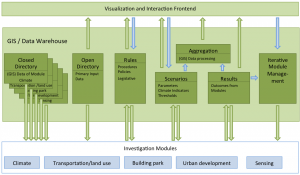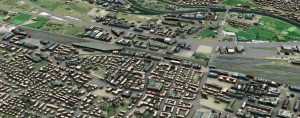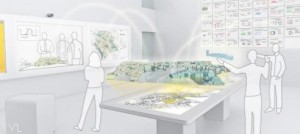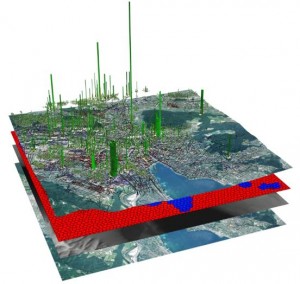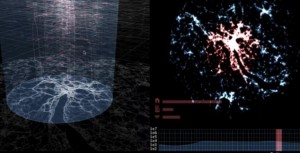Fig.: GIS/data-warehouse architecture.
The Integration and Interaction (WP2) work package has three main objectives: (a) the setup of a generic GIS/data-warehouse to integrate the separated databases of the individual modules, to provide interconnectivity and to provide shared data access for all modules, (b) the visualization and interaction frontend for stakeholder assessments and (c) the evaluation separated modelling tools. Ideally, the data schemes can be easily transferred to different case studies and pose in those way interesting business opportunities.
GIS/data-warehouse
An integrated GIS/data-warehouse (figure above) is responsible for data storage and serves as a centralized data hub for all modules. This will enable the project to work at any time with consistent data, to have the warehouse enclosed both GIS based and geo-independent data. The GIS/data-warehouse will be designed to be adaptable to data privacy requirements of different legal contexts (governmental, business and private use of the results). Different methods for the anonymisation of sensitive data will be included to derive at synthesized data, which can be shared and modified within the project between partners and in later business segments (e.g, cloud-based GIS/data-warehouse).
Within the GIS/data-warehouse two types of data are stored. First stage synthesized serves as preconditions to run the different simulations data (e.g. geo-specific, socio economic, technical and climate relevant data). This data will be assigned geographically and therefore allow for interchange for instance with agent based models. Furthermore, second stage data (results of the simulations) is stored in the warehouse, making them available for other modules, or for visualization purposes. Module-independent software tools enable data aggregation for visualization (e.g. total carbon derivative usage and greenhouse gas production, total energy demand). Climate relevant thresholds for visualization and comparison with obtained data are enclosed in the warehouse.
Moreover, procedural rules, e.g. building codes, design, conditional and behavioural patterns, or regulations, are typical datasets, which will be integrated into the warehouse. They need to be cumulated with regional knowledge from the case studies and will be stored as regional adaption rules for describing local specifics and identities. Rules are especially relevant for the city development module, but essentially affecting all modules. A separate core component of the warehouse is the scenario management, which interfaces parameter values and input data to build up user-specific scenarios. Another capability of the GIS/data-warehouse is to store temporal changes. This is necessary to organize and access time-dependent data when running the simulation for different simulated time periods or for interpreting and comparing the results between calculated scenarios and with census data. A distinct investment will be made to create pre-computed template scenarios, which will support a fast role out to the final clients and enable on top of this fast data streams for flexible visualization possibilities.
The exact design of the GIS/data-warehouse needs to be specifically adapted to each of the processed cities or regions, e.g., (a) availability of data, which may depend on the structure and interplay of the municipal planning departments, (b) and to publish the results for democratic activities (e.g., public referendum on adaptation strategies).
The warehouse interfaces and addresses the interdependencies between the modules and the parameters. Modules get an assigned data frame containing all the relevant data for their computational tasks. Specification will be implemented, which data need to be exchanged with other modules and which data can be stored for each module within a storage pool with temporal snapshot capabilities. A software-based management tool, which will be accessible from the web-based front end (WP 2), (re-) starts the modules iteratively until convergence or divergence is reached. An optimization framework tracks potential counter effects behaviour between modules. This feedback will be reported and incorporated into web-based front end (WP 2) in that form that parameters can be easily adjusted and parts of the calculations will be re-run with the modifications.
Data security and access rights are especially emphasized in the project. Data is stored separately in open and closed access zones, accounting for different property rights and access roles. Additionally, sensitive data and simulations are hidden, and only the outcomes are visible for the normal end-user. Version control functionality will be available from within the database. The GIS/data-warehouse will be prepared to easily store data in existing computing centres and concurrently to cloud-based storage pools. Therefore, a key advantage of the warehouse is its modular and open architecture, in comparison to a fully integrated simulation platform, which would try to encompass the functionality of all current modules into one integrated simulation software. The design of the database will focus on minimizing data requirements for each module and to overcome low data availability, e.g. through by-pass strategies to solve “missing value” problem more efficiently.
Visualization and Interaction Frontend
Participatory urban planning for a cross-disciplinary assessment needs interactive tools to merge visualisation and simulation provided feedback with the insights of the case study stakeholders. Cloud based modelling and visualisation tools will strength the interaction and the data deployment.
The objectives of the ‘Visualization and Interaction Frontend’ work package are: (a) the implementation of a procedural model with 3D city model and information visualization capabilities, (b) an interaction frontend for real-time city modelling for participatory assessments, which will provide direct feedback in a user-friendly manner as inputs for the simulation modules.
Procedural Model
A procedural urban model offers several advantages compared to common analogue and digital city modelling approaches. First, the generated model components are rule-based and parametric. Second, the level of detail can be seamlessly adjusted. Because of its rule-based nature parts of model can be generated on the fly and efficiently iterated as well mixed with existing fixed modelling data sets.
Such a procedural model can be used (a) to create high quality 3D city models efficiently, semi-automatically, (b) to create context-sensitive map-based or 3D information visualizations automatically and (c) to report computed and evaluated geometries.
The rule-based generation of urban geometries (buildings, streets, street furniture, vegetation) can be set up as context-sensitive geometry generating functions. In that sense data from the GIS/data-warehouse can drive the model generation as input parameters. A city model for spatial exploration can be automatically created and the quality of the model can be incrementally adapted, e.g., from low resolution models for covering whole cities (e.g., as input for urban climate evaluation) up to high resolution models of building faces and street canyons to value urban qualities as well as to query the potential energy consumption by each building.
Rather abstract simulation data, such as wind flow vectors, heat maps or temporal snapshots of agent-based traffic simulations can be easily integrated and visualized in understandable ways. For instance traffic modes, such as car movement can be easily placed in to the procedural model for visualization.
Further generated GIS based city models can be queried in regard to generated instances (trees, cars), surfaces (facade materials) and volumes. This data can be reported back to the database (e.g. reported instances of building materials) and feed back into a contextual information visualization within the procedural model (figure below).
Fig.: Interactive visualization of the procedural reconstruction of Altstetten district, City of Zurich.
A procedural urban model of the case studies will be created through a set of rules consisting building codes, design pattern or regulations, which are components of the GIS/data-warehouse (WP2). The resulting model will serve as the shared ground for all modules, which need to access a city model based on n-dimensional (geometry and associated meta data) rule-based reconstruction. The procedural model further serves as a central input for the cloud based data- and visualization-platform.
Interaction Frontend
Fig.: Impressions of assessment workshops within the collaboration environment ETH Value Lab.
The interaction frontend is the interface to all collaborating parties, e.g., stakeholders, research institutions and business partners. It is used for the central aggregation of several visualizations and the creation of user-based model feedbacks – either derived from simulation modules or through the visualization platform. It consists of interdependent modular decision support tools for the cross-sectoral, multi-scale planning, management and operation of existing cities.
These decision support tools are available through assessment workshops in the ETH Value Lab (figure above), a collaboration environment to visualize and assess various planning scenarios. The ETH Value Lab combines hardware, software and interaction to further visual insights from experts to stakeholders in a (lay) user-friendly computer environment. Further the infrastructures present in the Value Lab can be easily simplified and adapted, e.g., to role out Value Lab systems to municipalities. A demonstrator case is currently set up at the “Future Cities Laboratory” in Singapore. The capabilities of the interaction frontend will go far beyond room-size installations. They will be web-based visualization and interaction services, which can be easily accessed from touch capable mobile devices, tablet PCs and (non mandatory) high-end workstations.
The interaction frontend will provide activities such as expert explorative sessions for planning scenario evaluations, interdisciplinary participatory workshops and will be accessible for learning and educative activities with reference to system approaches covering climate mitigation or adaption techniques. An important notion will have the integration of current web-based social networks, which can be leveraged to certain extend for participatory planning and for public referendum.
The main objectives of the interaction frontend are: (a) the visualization of implementation strategies that pursue goals such as the 2000-Watt-Society or the 1-Ton-CO2-Society, (b) communication of key indicators to participants already during assessment workshops and (c) evaluation of various planning scenarios regarding optimization of urban environments and increase of urban quality.
The interactive vizualisation and analysis results (figures below) support the evidence-based decision-making with the community and end-users, saving costs and time, enabling the creation of a mutual vision, supporting a broad understanding and acceptance of final planning decisions.
Fig. left: Interactive scenario visualization of location-based energy use, heat waste and carbon dioxide emission. Fig. right: Interactive visualization of temporal and modal interdependencies within traffic systems in City of Zurich.
Learning Module
The learning work package deploy the individual modules in form of separated modelling tools in the real-world setting of the case study areas, to (a) optimise investments, facilitate community engagement, and (b) provide assessment feedback regarding the modelling tools and their validity in supporting the decision making process. This module serves further as an integrative evaluation part where all the systemic interdependencies within urban environments will be investigated. This module will give direct feedback on customer requirements, practicalities and learning modes, which needed to be fed into the progressed development of each simulation module. Hence the evaluation work package additionally contains the organization and realisation of workshops for learning scenario-based climate adaptation and mitigation strategies along with interactive and satisfactory balancing of the urban development path parameters. Therefore stakeholder workshops will be organized with the early adopters City of Zurich and City of London.

